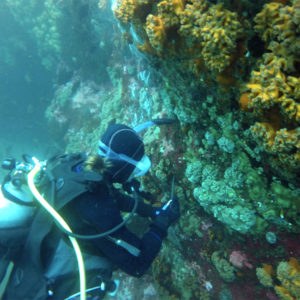Heather Glon has trouble keeping her head above water — mainly because her research requires her to travel around the world diving for sea anemones.
Glon, a PhD student in the Department of Evolution, Ecology and Organismal Biology at The Ohio State University, is attempting to gather a globally representative collection of Metridium, a type of sea anemone that thrives in the northern Atlantic and Pacific oceans. By looking at relationships between genetics and geographic distribution, she hopes to understand how and why the anemones have evolved over time.
“It’s a very variable group of sea anemones in terms of how it looks — it can be fat or skinny; big or small,” Glon said. “Divers love it because it can be really striking when you see a whole bunch of them together.”
They may look like vibrant, underwater gardens — sea anemones are actually named after the “anemone” flower — but Metridium is far from plant life. Covered in venomous cells, the marine animals spend their days patiently waiting for fish and other small organisms to swim close enough to become trapped in their toxic tentacles (check out the work of Glon’s advisor Meg Daly on sea anemone venom).
As a diver herself, Glon has become quite familiar with the colorful creatures, which are generally harmless to humans. Many of her 100+ dives around the world have been tailored to searching for Metridium (also known as plumose anemones), including expeditions along the coasts of Japan, Ireland, Norway, the Canadian Maritimes and the Northeastern U.S., among others. She holds Advanced, Rescue and Master Scuba Diver certifications and has dove to depths of up to 100 feet.
She is looking at genetic data from the anemone samples she’s acquired, in addition to those collaborators have sent her, “to determine which species came from which oceans originally; how much connection there is between both sides of the Atlantic; how many total species there are, etc.,” she said. “There are a lot of questions that we’re looking at.”

Comments are closed